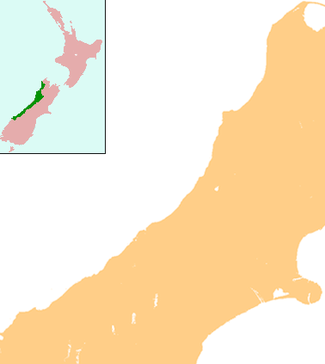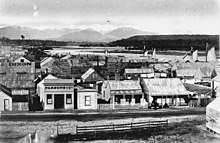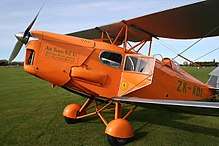Hokitika
Hokitika is a small town in the West Coast region of New Zealand's South Island, 40 kilometres (25 mi) south of Greymouth, and close to the mouth of the Hokitika River.
Hokitika | |
|---|---|
 Hokitika township | |
 Hokitika | |
| Coordinates: 42°42′56″S 170°58′5″E | |
| Country | New Zealand |
| Region | West Coast |
| District | Westland District |
| Settled by Europeans | 1864 |
| Electorates | West Coast-Tasman Te Tai Tonga |
| Population (June 2019)[1] | |
| • Total | 3,090 |
| Time zone | UTC+12 (NZST) |
| • Summer (DST) | UTC+13 (NZDT) |
| Postcode(s) | 7810 |
| Area code(s) | 03 |
| Local iwi | Ngāi Tahu |
According to the 2013 New Zealand census, the usually-resident population of the Hokitika urban area was 2,967, a decrease of 111 people since 2006.[2] There are 876 people living in rural Hokitika, an increase of 48 people since the 2006 Census.[3] On a clear day Aoraki / Mount Cook can clearly be seen from Hokitika's main street.
History


Founded on gold mining in 1864, it was a centre of the West Coast Gold Rush. By late 1866, it was one of New Zealand's most populous centres. On 16 September 1867, there were 41 vessels alongside the wharf at Hokitika, in some places three and four deep. In 1867, the port of Hokitika ranked first in New Zealand in both the number of vessels entered inwards and in the total value of exports; principally gold.
On 8 March 1868 a mock funeral was held in protest about the conviction and hanging of three Irish Fenians in Manchester – the Manchester Martyrs. The funeral was led by Roman Catholic Father William Larkin and a Celtic Cross was erected in the cemetery. Larkin was later arrested, charged, and convicted of riot and seditious libel.[4]
In 1873 Hokitika became the capital of the short-lived Westland Province which lasted from 1873 until the abolition of provinces in 1876.
In October 1941, three Hokitika police officers (and a policeman stationed in the neighbouring locality of Kaniere), along with a field instructor for the Canterbury education board, were killed when a local farmer, Stanley Graham, went on a shooting rampage and killed seven people, including two armed Home guard personnel.
In the ensuing manhunt, the biggest in New Zealand history, overseen by the Commissioner of Police, Denis Cummings, more than 100 New Zealand Police and several hundred New Zealand Army & Home Guard searched the area for the gunman for 12 days, with orders to shoot him on sight if found still armed. On 20 October, after being spotted by two police constables and a local civilian carrying his rifle and ammunition belts, Graham was fatally wounded by a police constable and died the next day.[5]
The population has declined greatly since that time but the population of the Westland District is now on the rise thanks to "lifestyle inhabitants". Almost 30% of the district's rate-payers live outside of Hokitika.
Eleanor Catton's Man Booker Prize-winning novel The Luminaries is set in gold rush-era Hokitika.[6]
Economy
The major industries of greenstone (pounamu), gold, coal, and forestry have all dwindled over the last century, but a growing ecotourism industry has grown up and the town is starting to show signs of recovery. It has become a major tourist stop on the West Coast's main highway route, with carving of greenstone an important local industry. It is also gaining a reputation for its annual wild food festival which has been running since 1990.[7] Seaview Asylum was once the town's biggest employer.[8]
Another important industry is dairying, with Westland Milk Products being based in the town. A co-operative that has been producing dairy products for many years, Westland is increasing its production at about 10% annually, and in recent years has installed plants to produce new products such as different types of proteins, AMF and others. The vast majority of its production is exported.
The Hokitika Sock Machine Museum in town has on display a collection of antique sock-knitting machines and invites visitors to knit their own socks.[9]
Hokitika now boasts one of South Island's best 3D digital cinemas,[10] the Regent Theatre,[11] due to volunteer hours[12] and grants from the Westland development trust, Lions foundation, Lottery's commission, the Major District Initiative[13] and pub charity. The Art Deco theatre narrowly avoided being demolished, thanks to a last-minute coup in the management committee.[14]
Culture
Arahura Marae is located near Hokitika. It is a marae (tribal meeting ground) of Ngāi Tahu and its Te Rūnanga o Ngāti Waewae branch, and includes the Tūhuru wharenui (meeting house).[15][16]
Hokitika has a thriving drama group which produce excellent plays. It is also on the circuit for Arts on Tour and well known artists from many countries as well as New Zealand perform at the Old Lodge Theatre.
The Regent Theatre is a Heritage Building with up-to-date digital equipment and shows the latest movies in 2 theatres. Community performances are also held there.
There is also a popular museum, a well used, modern library, thriving community groups and many excellent artists.
Transport
State Highway 6 passes through the town.
Air New Zealand provides two flights a day to Christchurch. The Hokitika Airport is adjacent to the town, immediately to the north-east in the suburb of Seaview.
The Hokitika Branch line runs to the town from Greymouth, connecting there with the Midland Line to Christchurch.
Rail
The first rail transport was the Hokitika & Kanieri Tramway laid with wooden rails was established in 1868, with cars drawn by horses.[17] A road followed in 1873.[18]
A branch line railway known as the Hokitika Branch was established to the town from Greymouth in 1893, and an extension to Ross was open from 1909 to 1980.
Passengers to Hokitika were initially served by mixed trains that carried both goods and passengers. In 1936, these services were augmented by a Leyland diesel railbus service that ran from Hokitika to Greymouth, Christchurch, and briefly Reefton. In the early 1940s, the Vulcan railcars were introduced and they provided a twice-daily service between Ross and Christchurch via Hokitika. The mixed trains continued to operate until 1967, and all passenger services to Hokitika ceased when the Vulcan railcars stopped running past Greymouth in 1972.
Since then, the line to Hokitika has been freight only with traffic primarily coming from Westland Milk Products.
Shipping
In 1865, after the discovery of gold in the area, the town became the official port of entry of the West Coast. A boom period ensued when Hokitika was second only to Auckland, with reports of over 40 ships in the harbour at one time, with more waiting offshore.
It was a dangerous port, however, with 108 strandings and 32 ships lost from 1865 to 1867. The lack of nearby coal meant that the port declined rapidly along with the gold, though Hokitika remained an official entry port until the 1950s.[19]

ZK ADI, Air Travel's first aircraft
Airline
Hokitika's Southside airfield was the base of Air Travel, New Zealand's first airline. Air Travel carried passengers, mail and freight south from Hokitika to the glaciers and remote landing strips beyond Haast and north up to Westport. Its first scheduled flight was in December 1934. Directors were Hokitika residents: Bert Mercer, Paul Renton and Harry Newman.
After the second world war Air Travel was nationalised and became part of NAC.
Geography
Climate
Hokitika has a wet oceanic climate. It is one of the wettest places in New Zealand.
| Climate data for Hokitika Airport (1936–2015, Humidity 1961–2015, Sunshine 1964–2015) | |||||||||||||
|---|---|---|---|---|---|---|---|---|---|---|---|---|---|
| Month | Jan | Feb | Mar | Apr | May | Jun | Jul | Aug | Sep | Oct | Nov | Dec | Year |
| Record high °C (°F) | 29.7 (85.5) |
28.4 (83.1) |
26.7 (80.1) |
24.5 (76.1) |
26.7 (80.1) |
18.6 (65.5) |
18.8 (65.8) |
19.8 (67.6) |
22.8 (73.0) |
24.0 (75.2) |
27.4 (81.3) |
27.1 (80.8) |
29.7 (85.5) |
| Average high °C (°F) | 19.4 (66.9) |
19.8 (67.6) |
18.8 (65.8) |
16.6 (61.9) |
14.3 (57.7) |
12.3 (54.1) |
11.9 (53.4) |
12.6 (54.7) |
13.8 (56.8) |
14.9 (58.8) |
16.4 (61.5) |
18.2 (64.8) |
15.7 (60.3) |
| Daily mean °C (°F) | 15.5 (59.9) |
15.9 (60.6) |
14.7 (58.5) |
12.6 (54.7) |
10.1 (50.2) |
8.1 (46.6) |
7.4 (45.3) |
8.3 (46.9) |
9.8 (49.6) |
11.1 (52.0) |
12.6 (54.7) |
14.4 (57.9) |
11.7 (53.1) |
| Average low °C (°F) | 11.7 (53.1) |
11.9 (53.4) |
10.7 (51.3) |
8.5 (47.3) |
6.0 (42.8) |
3.8 (38.8) |
2.9 (37.2) |
4.0 (39.2) |
5.8 (42.4) |
7.3 (45.1) |
8.7 (47.7) |
10.7 (51.3) |
7.7 (45.9) |
| Record low °C (°F) | 4.7 (40.5) |
3.5 (38.3) |
−0.4 (31.3) |
−0.7 (30.7) |
−2.2 (28.0) |
−3.2 (26.2) |
−4 (25) |
−2.9 (26.8) |
−2.1 (28.2) |
−1.3 (29.7) |
−0.6 (30.9) |
2.9 (37.2) |
−4 (25) |
| Average rainfall mm (inches) | 242.3 (9.54) |
178.9 (7.04) |
215.0 (8.46) |
235.8 (9.28) |
242.1 (9.53) |
249.3 (9.81) |
219.3 (8.63) |
231.9 (9.13) |
256.5 (10.10) |
276.3 (10.88) |
239.6 (9.43) |
268.5 (10.57) |
2,849.7 (112.19) |
| Average rainy days (≥ 1.0 mm) | 12.4 | 10.4 | 12.6 | 13.3 | 14.7 | 13.8 | 13.5 | 14.8 | 16.8 | 17.3 | 15.0 | 15.8 | 170.5 |
| Average relative humidity (%) (at 9am) | 83.1 | 85.9 | 85.5 | 86.0 | 87.5 | 87.1 | 85.5 | 84.2 | 82.3 | 81.9 | 80.6 | 81.9 | 84.3 |
| Mean monthly sunshine hours | 209.5 | 186.8 | 171.9 | 139.9 | 119.2 | 104.0 | 124.3 | 138.9 | 142.8 | 164.1 | 181.1 | 194.6 | 1,877 |
| Source: CliFlo[20] | |||||||||||||


Education
A school was described as "recently opened" in Hokitika in 1875, and had nearly 350 students.[23] The Hokitika District High School provided both primary and secondary education for the area for many years. Its name was changed in 1963 to Westland High School, which caters for years 7 to 13 and has a decile rating of 6 and a roll of 373.[24] Hokitika School is a contributing primary (years 1–6) school with a decile rating of 4 and a roll of 170.[25]
St Mary's School is a full primary (years 1–8) school with a decile rating of 5 and a roll of 153.[26] It is a state integrated Catholic school[27] and is connected with St Mary's Catholic Church.
All these schools are coeducational.
In popular culture
The events of The Luminaries, by Eleanor Catton, take place within Hokitika. The book won the Man Booker Prize in 2013.
See also
References
- "Subnational Population Estimates: At 30 June 2019". Statistics New Zealand. 22 October 2019. Retrieved 11 January 2020.
- "2013 Census QuickStats about a place:". Statistics New Zealand. Statistics New Zealand. Retrieved 21 January 2015.
- "2013 Census QuickStats about a place:". Statistics New Zealand www.stats.govt.nz. Statistics New Zealand. Retrieved 21 January 2015.
- What is Truth, Newsletter – Friends of the Cathedral, Number 71, September 2007, Cathedral House, Christchurch
- H. A. Willis (1979), Manhunt : the story of Stanley Graham, Whitcoulls, ISBN 978-0-7233-0629-0
- Why you should read The Luminaries
- "The story so far..." Archived from the original on 2007-03-03.
- "Greymouth unit open". The Press. 1 January 2009. Retrieved 23 August 2011.
- Hokitika Activity Guide.
- Xpand news Archived 2013-02-09 at Archive.today
- Theatre web Site
- cinema treasures
- $340k funding
- today 3d article
- "Te Kāhui Māngai directory". tkm.govt.nz. Te Puni Kōkiri.
- "Māori Maps". maorimaps.com. Te Potiki National Trust.
- Rogers, p 63
- Rogers, Anna (2005). Illustrated History of the West Coast. p. 63. ISBN 0-7900-1022-4.
- "Hokitika Customhouse". Register of Historic Places. Heritage New Zealand. Retrieved 2009-05-02.
- "CliFlo – National Climate Database". NIWA. Retrieved 13 December 2015.
- https://www.backpackerguide.nz/23-unforgettable-walks-hokitika/ "Arguably the most scenic swingbridge in New Zealand!"
- http://www.doc.govt.nz/parks-and-recreation/places-to-go/west-coast/places/hokitika-gorge-scenic-reserve/things-to-do/tracks/hokitika-gorge-walk/
- "Hokitika School" (3129). West Coast Times. 15 October 1875. p. 2.
- "Te Kete Ipurangi – Westland High School, New Zealand – Westland High School". Ministry of Education.
- "Te Kete Ipurangi – Hokitika School". Ministry of Education. Archived from the original on 2008-10-18. Retrieved 2008-08-05.
- "Te Kete Ipurangi – St Mary's School, Hokitika – St Mary's School". Ministry of Education. Archived from the original on 18 October 2008. Retrieved 21 June 2012.
- "Education Review Report: St Mary's School Hokitika". Education Review Office. May 2008.
External links
| Wikivoyage has a travel guide for Hokitika. |
| Wikimedia Commons has media related to Hokitika. |
